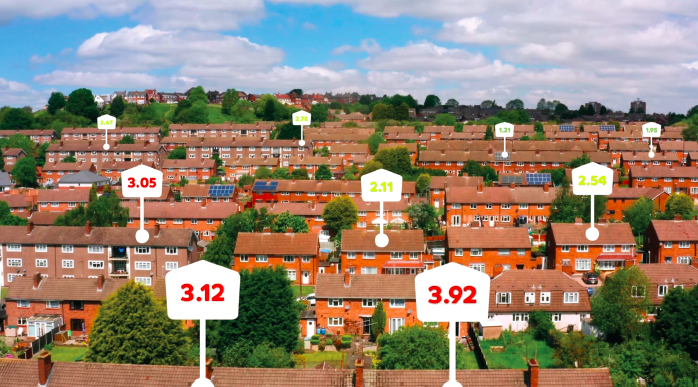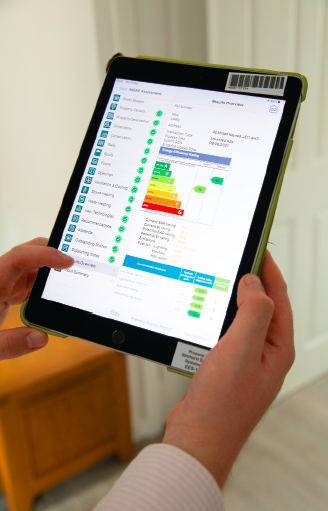
Stuart Fairlie, Managing Director at Elmhurst Energy talks to PHPD about why measured energy performance is crucial for the homes of the future.
It’s widely accepted that 20% of the UK’s carbon emissions come from our buildings. But how accurate is this? At the moment, many of our efforts to measure and decarbonise our buildings are based on calculations, such as the standard assessment procedure (SAP) currently used to determine a property’s energy performance certificate (EPC) rating. This involves assumptions on a building’s location, amount of heating, and air temperatures.
This means our goals of reaching net zero by 2050 and reducing the carbon footprint of our homes could, in fact, be further – or closer – than we think.
To combat this, the industry can and should now be looking to use more accurate data instead of assumptions, wherever possible.
Measured energy performance (MEP) is a solution to this. It is the method of assessing building heat loss using on-site measurements, rather than relying on energy models.
What is measured energy performance?
Every building is different. As we push for net zero, it is crucial we measure and understand how buildings use energy and how well they perform in practice.
Measured energy performance testing focuses on the measurement of Heat Transfer Co-efficient, or HTC. As it stands, it is a measurement that is predicted in SAP, RdSAP, and other energy models. But there are now a handful of technologies that can measure the actual figure in-situ.
MEP assessors are pushing the industry forward, using these technologies to provide a greater understanding about our buildings. The data can be used to identify any potential issues or defects in the property, providing evidence needed for further investigations or data-driven decision making.
Why is MEP important for housebuilders?
Housebuilders should be considering measured energy performance as it plays a crucial role in demonstrating compliance with the Future Homes Standard (FHS), in force from next year. The FHS sets out an option for demonstrating that any potential performance gap has been eliminated in new build homes. This means there is likely to be a surge in demand for MEP.
Delivering net zero carbon-ready new build homes is a major piece of the jigsaw for achieving net zero by 2050. However, many housebuilders are already there or are nearing this point.
MEP can deliver data that proves homes’ energy performance matches the intent at design.
By performance testing new homes, this shows that the Future Homes Standard requirement for 75-80% lower carbon emissions has been met.
Energy efficiency demand
According to OVO, more than two-thirds of prospective homebuyers in the next two years are specifically looking for houses with green installations that improve energy efficiency and reduce carbon emissions.
This comes as no surprise with energy bills currently sitting at around £1,568 for a typical household using dual fuel, based on the last Ofgem price cap.
Recent figures on house values also echo this. Nationwide recently compared average prices in England and Wales in the 12 months leading up to June 2024 and found that properties with a high A or B EPC rating achieved on average 2.8% higher premium. While we know EPCs cannot accurately determine the energy efficiency of a property, this remains a stark indicator.
It is becoming a demonstrable commercial benefit to housebuilders that can prove their homes are a cut above on energy efficiency.
 Many home buyers are willing to spend more on a building that is cheaper to heat, knowing they will live more comfortably and reap financial benefits in the longer term. MEP could become a useful tool for housebuilders to differentiate themselves from competitors, gaining an early competitive advantage and reputation for demonstrably better performing, energy efficient homes.
Many home buyers are willing to spend more on a building that is cheaper to heat, knowing they will live more comfortably and reap financial benefits in the longer term. MEP could become a useful tool for housebuilders to differentiate themselves from competitors, gaining an early competitive advantage and reputation for demonstrably better performing, energy efficient homes.
Formalising MEP
Elmhurst has worked to formalise MEP as a new method of measuring building energy performance for almost four years in a range of pilot projects.
It was an early supporter of the government-funded Smart Meter Enabled Thermal Efficiency Ratings (SMETER) innovation programme, exploring the use of measured, rather than calculated energy performance.
This culminated in the recently launched, first-of-its-kind Measured Energy Performance Competency Scheme, to prepare the energy efficiency industry for increased demand in these skills, particularly from the housebuilding sector.
Measured energy performance is also part of a wider toolbox of competencies that go into providing a complete picture of building performance, including airtightness testing, U-value calculations for walls, roof and floors and ventilation testing.
Many of these, such as airtightness testing, are now commonplace following the Part L and Part F updates to Building Regulations in 2021.
Now, integrating MEP into the mix is the next step for housebuilders who want to make sure they are ahead of the curve when the Future Homes Standard arrives next year.










